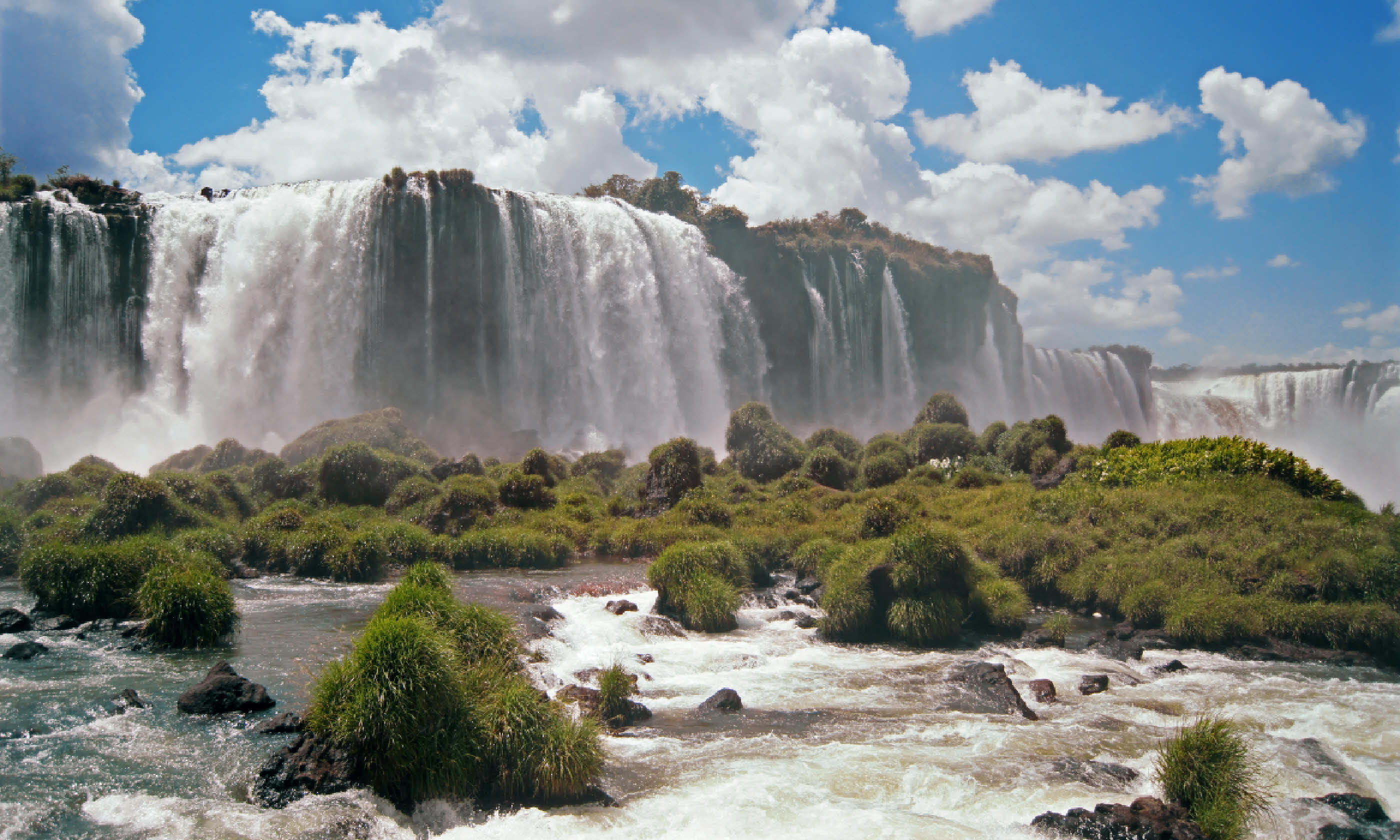
Legends of Iguazú Falls
Iguazú Falls is where three countries collide, so if you’ve got a week you can explore Brazil, Argentina and Paraguay in a single trip for a real South American adventure...
Samuel Taylor Coleridge, who had a thing about waterfalls, noted in his 1799 diary: ‘What a sight it is to look on such a cataract. The wheels that circumvolve in it, the leaping up and plunging forward of that infinity of pearls and glass bulbs. The continuous change in the matter, the perpetual sameness of the form.’
Alas for him, Coleridge never set eyes on Iguazú Falls. It was Aira Force, a piddling (by comparison) cascade in Cumbria that got his lyrical and philosophic juices flowing. What, I wondered, might the Romantic poet have made of the Garganta del Diablo – ‘Devil’s Throat’ – the highest and mightiest single drop in the world’s most mesmerising falls?
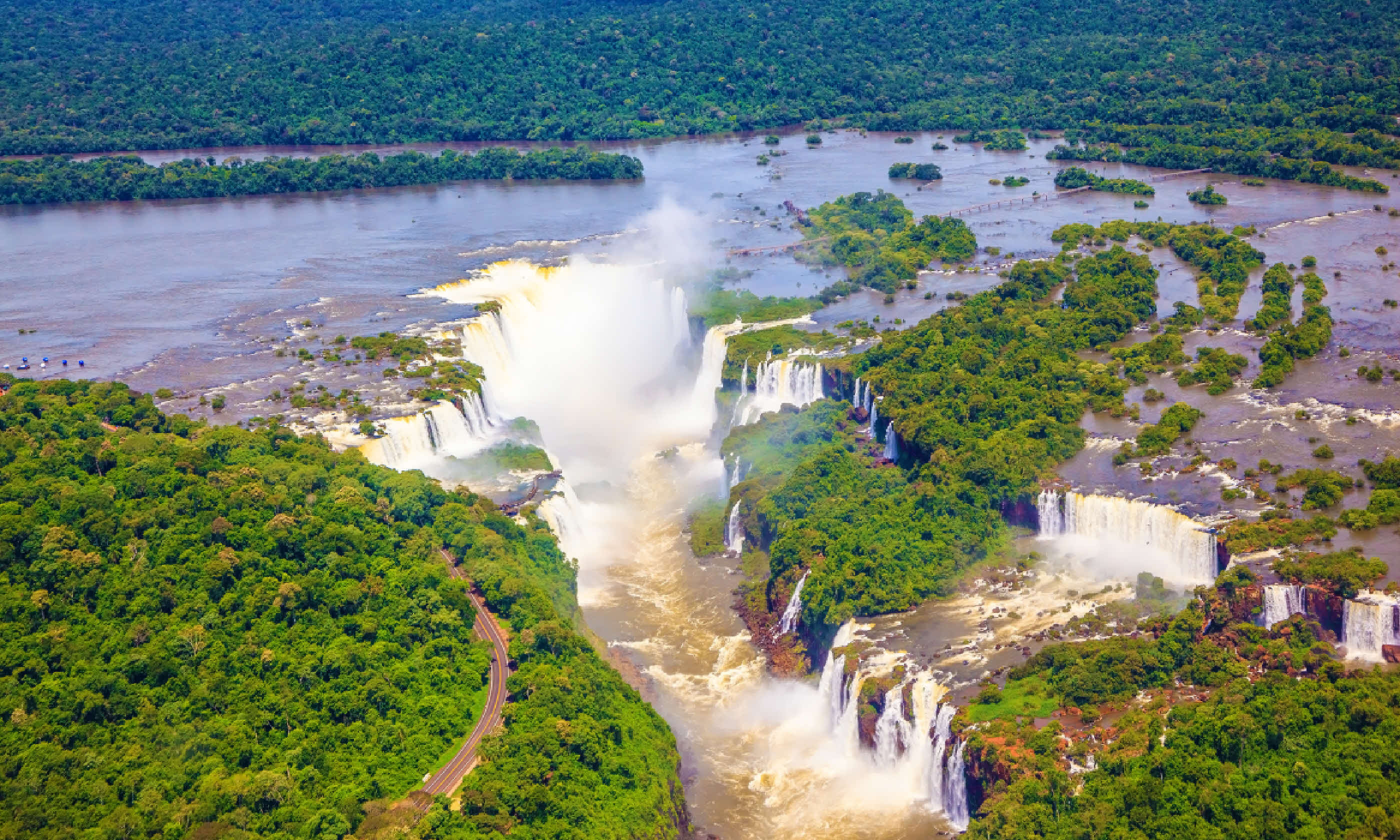 Devil's Throat - largest waterfall of Iguazu Falls
Devil's Throat - largest waterfall of Iguazu Falls
I was crawling on my stomach to the edge of the diabolical abyss, where every second millions of litres of the coke-coloured Iguazú River flow calmly past a wooded islet then plunge in slow motion over a precipice. In the thunderous white frenzy, I too saw leaping pearls, plunging bulbs, continuous change and perpetual sameness.
Devil’s Throat or flight of angels? The latter, I decided, as a resplendent rainbow fleetingly spread its wings over this symphony of sight, sound and diving swifts, then dissipated in a blink.
Fall for the falls
All year round, planeloads of tourists descend on South America’s number one ‘must see’ natural wonder. The falls span the River Iguazú, which forms a border between Argentina and Brazil (where it is known, in Portuguese, as the Iguaçu).
Most visitors check them out from both sides in a camera-clicking whirlwind. They revel in blasts of elemental high drama, often including a bouncing rib ride up the gorge for a drenching in writhing coils of spray at the falls’ feet. They spend a couple of nights at a hotel in one country or the other, then fly out.
With a week to play with, my plan was to discover what other marvels this region holds. Remember that 1986 film
The Mission with Jeremy Irons and Robert De Niro? Shot in and around Iguazú, it shows off the scenery to extravagant effect, enriched by Ennio Morricone’s haunting score. What happened to the great Jesuit missions destroyed in this era? How much remains of the swathes of rainforest? And how about Paraguay, which slots into the jigsaw at a triple border with Brazil and Argentina, where the Iguazú gushes into the River Paraná?
First, though, the falls. They are created by an abrupt fault on a horseshoe curve of the River Iguazú. Numerous rocks and islands fragment the flow into different arms, each one forming a waterfall along a 2.7km arc. About three quarters of this length is on the Argentine side, the rest in Brazil with the 85m Garganta del Diablo shared between them. There are between 160 and 270 different cascades, depending on the volume of water.
My first glimpse was from the Brazilian side where I was lucky enough to be staying at the Belmond Hotel das Cataratas, a Portuguese colonial mansion within sight – and rumbling sound – of the falls. It is the only hotel within Brazil’s Parque National Iguaçu, which means that outside the 9am-5pm park opening hours, guests have exclusive access to the clifftop viewing platforms and forested pathways.
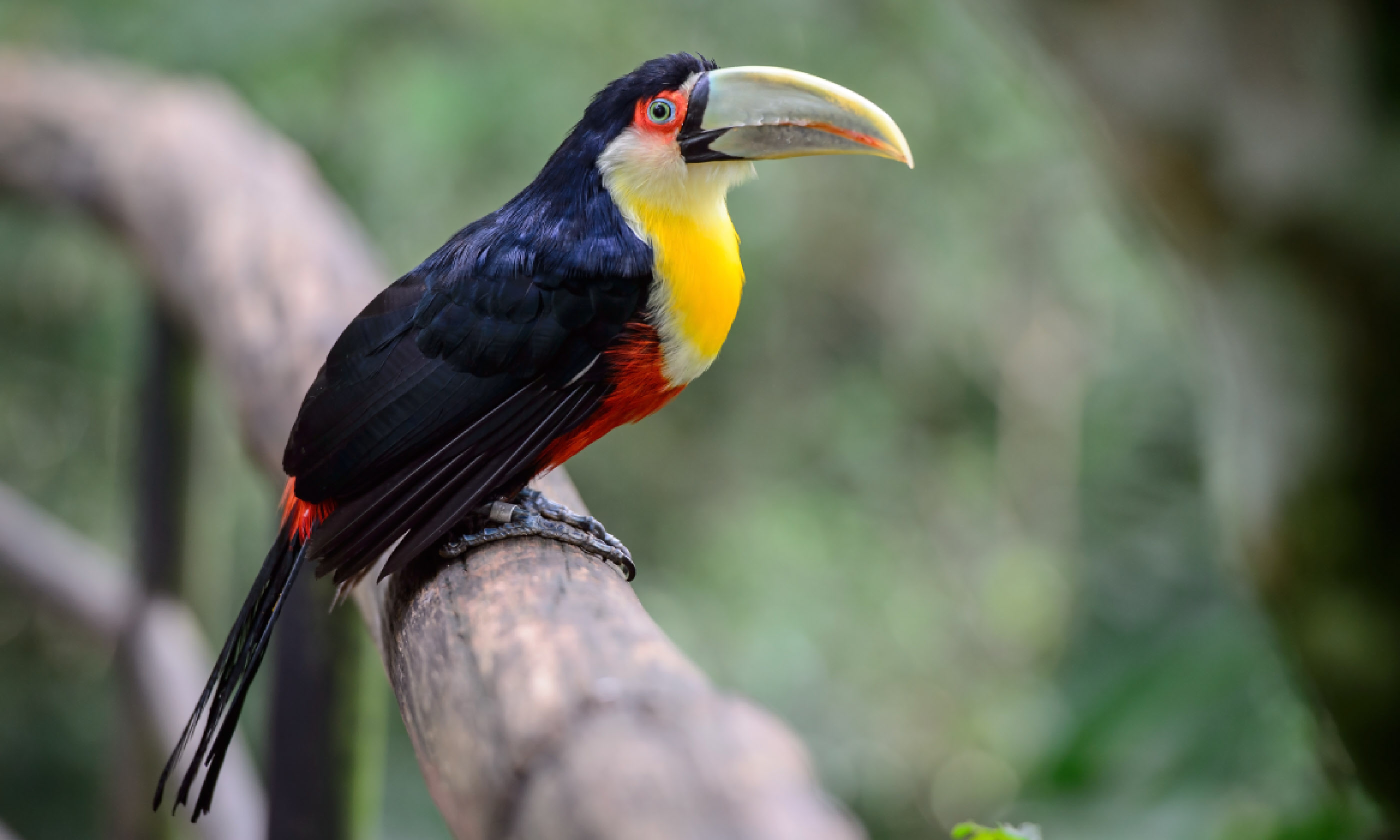 Toucan, National Park Iguazu, Brazil (Shutterstock)
Toucan, National Park Iguazu, Brazil (Shutterstock)
In early-morning solitude I chose a spot to relish the grandeur of the falls in the company of an inquisitive coati – a tame and cute-looking (but actually rather vicious) South American racoon – before breakfasting on fresh papaya and coffee so strong it made my head buzz.
Brazil and Argentina are rivals over everything from football to beef steaks to the depths of their national debts. When it comes to panoramas of the falls, the former scores with its walkways and viewing platforms. But Argentina gets an equaliser by allowing you up close and personal. Certainly, the Argentine side is a touch Disneyesque, with its little train from the visitor centre, but it is the place to get roaringly near and soaked – as I did crawling to the edge of the Garganta del Diablo.
On a mission
Back to
The Mission. The film is set in the 1750s, when vast tracts of the upper Paraná, Iguazú and Paraguay rivers were effectively an autonomous state ruled by Catholic religious order, the Jesuits. They did so by means of 50 or so
reducciones, or jungle missions, where indigenous Guaraní people lived, worked and were converted to Christianity.
However, when the Spanish and Portuguese crowns, threatened by growing Jesuit power, withdrew support and expelled them, the missions were plundered and burned by slave traders and their brutal mercenaries.
Of most missions, nothing remains. To reach one of the few whose ruins do survive, I drove 240km southwards from Iguazú along Argentina’s RN12, which traces the east bank of the Paraná River, facing the flat expanses of Paraguay’s Alto Paraná province across the tea-coloured water. The straight road streams through plantations of
yerba mate, a shrub cultivated to be drunk as an infusion.
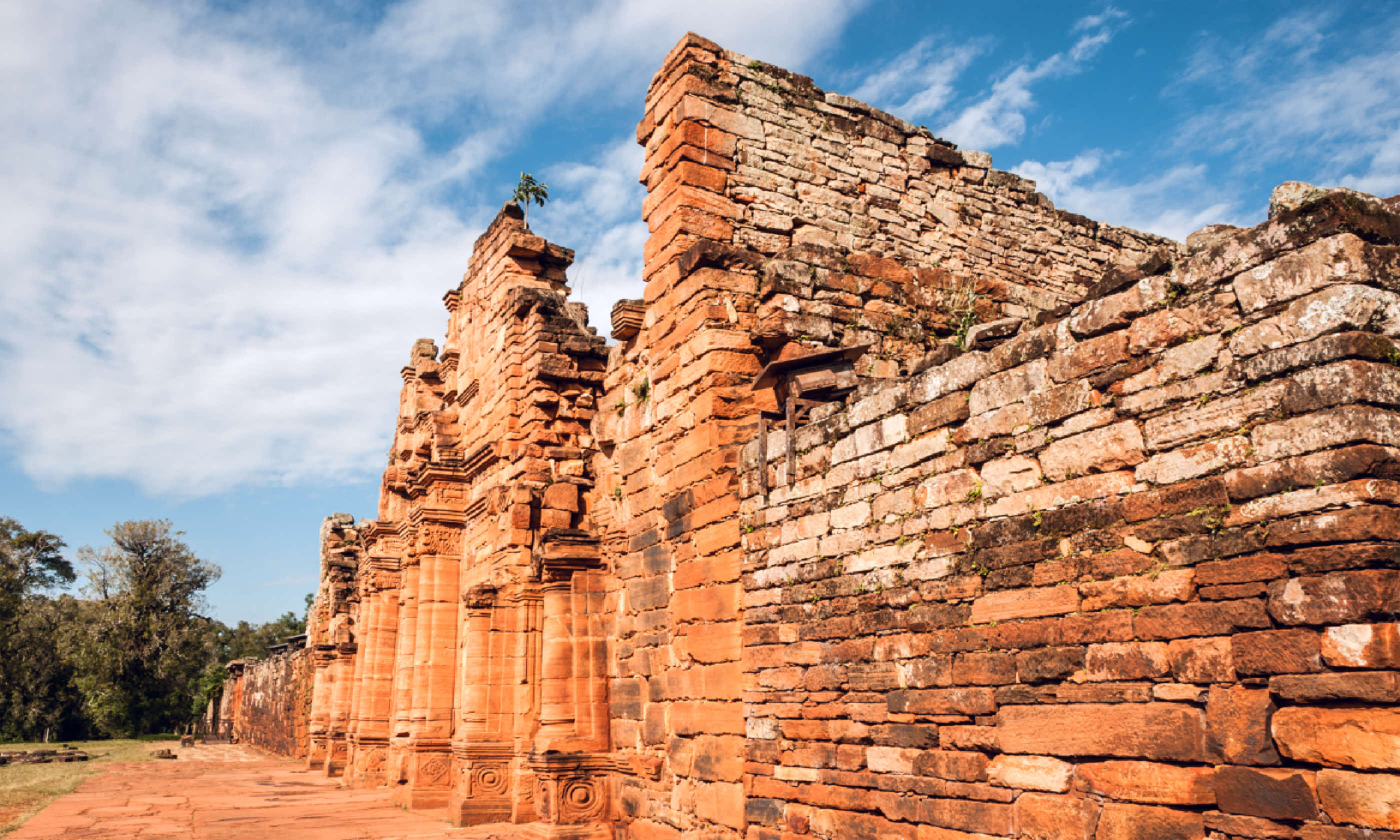 San Ignacio Miní mission
San Ignacio Miní mission
Entering the ruddy sandstone portals of San Ignacio Miní mission, I felt as if I was walking into a Gabriel García Márquez story. With a bit of concentration I was able to imagine it was the 1700s when 6,000 Guaraní and their Jesuit shepherds lived here, farming maize and singing psalms. I sensed a ghostly atmosphere among the roofless remains of stone dwellings while an eerie quiet hung over shady cloisters leading from the expansive main plaza to the looming ruins of the church.
The 75m-long nave with its broken walls and arches soaring out of a grassy floor reminded me of Glastonbury. A Glastonbury that Márquez might have dreamed up, with the tentacle-like branches of giant
ibapoi trees strangling pillars and an absurd-beaked toucan gliding by. I have seen many archaeological sites in South America, but it felt plain bizarre to be on this continent among the crumbled remains of a civilisation founded by Europeans.
So, the Jesuits: goodies or baddies? On the one hand, they protected the Guaraní from slave traders and communities that fused traditional culture with Christianity. On the other, they grew rich and powerful on the fruits of Guaraní labour. A shade of grey, I reckon.
The other Amazon
In Jesuit times, San Ignacio was hidden away in dense rainforest. Nowadays when we talk about South American jungle it is hard to think past the Amazon, but in the days of the missions, the quite distinct Atlantic rainforest blanketed an area five times that of Britain. As recently as 1970 it was half this size but, today, only about 6% survives.
Paraguay’s share has been completely razed, as has southern Brazil’s save for a sliver in Parque National Iguaçu. That leaves a few patches of Argentina’s Misiones province where the forest is now rigorously protected. So, rather than flying half way across the continent to reach the Amazon, I found a taste of rainforest on offer within easy reach of Iguazú falls.
Yacutinga Ecolodge is on a loop of the River Iguazú, with Brazil on the other side, a couple of hours upstream from the falls via a bumpy road and slippery red-clay track. It is not quite accurate to call the 570-hectare Yacutinga Reserve a ‘tropical’ rainforest since it is actually two degrees south of the Tropic of Capricorn. However, at first impression the lodge felt like others deep in Amazonia, give or take the main buildings’ rather unlikely mixture of hardwood trunks and curved exteriors with coloured glass, suggestive of Gaudí’s architecture.
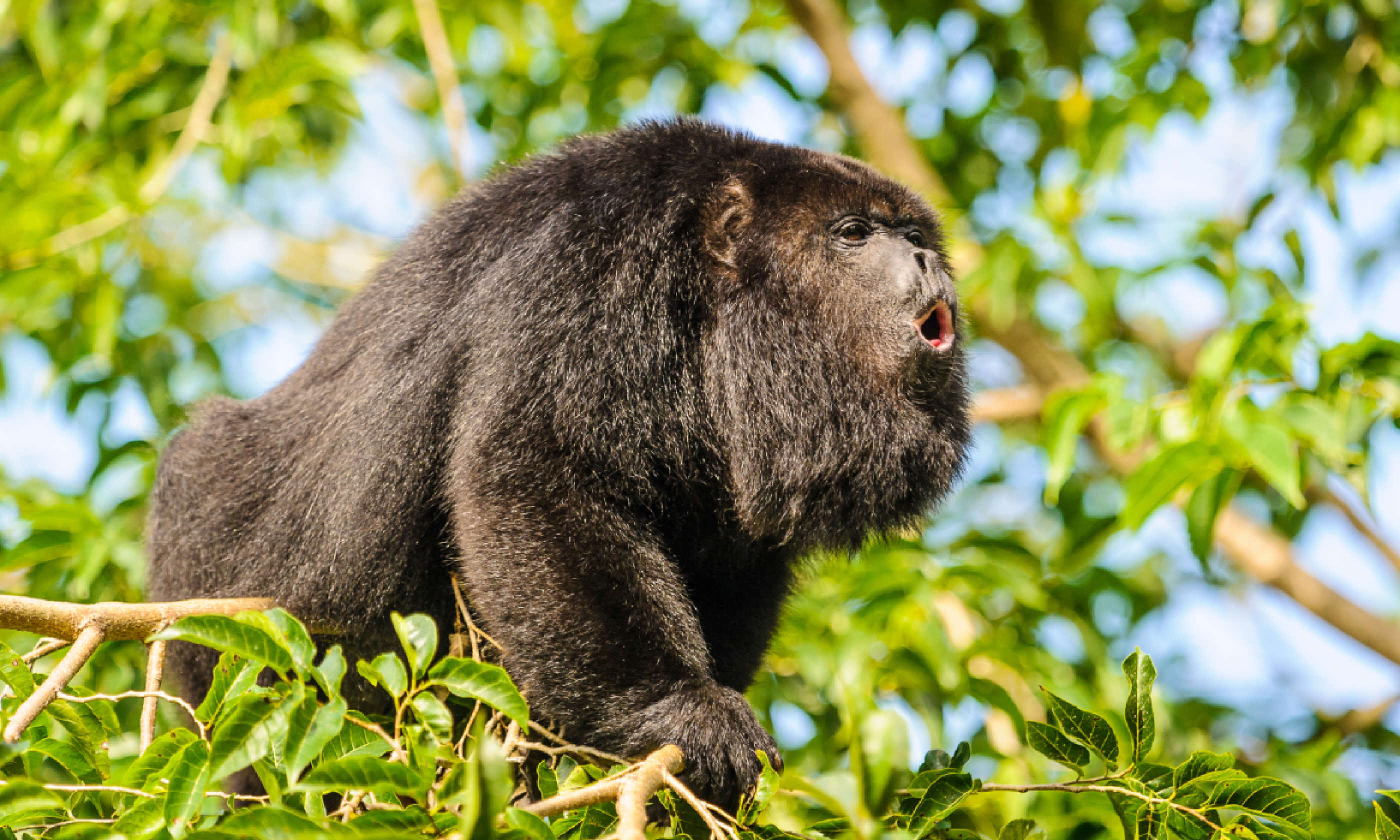 Howler monkey (Shutterstock)
Howler monkey (Shutterstock)
Earthy-scented air hung heavy in the warm glow of early evening as I climbed to a platform in the canopy. Here I sipped a cold beer while the percussive purring of cicadas rose to a screaming crescendo before the jungle noises eased to discordant shrieks, whistles and distant barking whoops.
Guests stay in comfortable, insect-proofed cabins in the forest, reached by paved pathways. It felt rather safe until, on my torchlit way to bed, I suddenly saw a pair of red slits in a greeny-yellow bulbous head, glinting from the undergrowth; a length of sinuous malice was coiled round a branch, eyes fixing me with quivering alertness. Then the Brazilian green snake (harmless, I discovered only later) slithered up a tree trunk and vanished.
Over the next couple of days I was to discover that wildlife is profuse in this small, rarefied microcosm of rainforest. Those barking whoops, it turned out, came from the black howler monkeys; they rarely piped down all night, though never showed themselves. Tufted capuchin monkeys, on the other hand, are diurnal and less shy; I was almost peed on by one troupe as they swung down from the canopy.
Daily activities at the lodge included hikes along forest trails with eager young guide Ricardo Jimenez leading his handful of guests. Machete-wielding Ricardo would raise his hand and identify, with authoritative precision, a greater nakedtailed armadillo here or a 150cm-long golden tegu lizard there. He also pointed out bark than can cauterise wounds and the ‘mil hombres’ tree, so-named because its sap serves as ‘natural Viagra’.
Next I opted to kayak down an oozing creek whining with dragonflies, where we spotted crested caracaras and various sub-species of toucan and kingfisher. The creek eventually seeped into the fast-flowing Iguazú; I reckoned that a float all the way down to the falls would have been fun, but the slow drive back was the only option on offer.
A little piece of Paraguay
And so to Paraguay. Views over the country’s featureless plains from the Argentine-side lookout offered few clues. A little way upstream the Ponte da Amizade (Friendship Bridge) joins Brazil’s Foz do Iguaçu town with Ciudad del Este, Paraguay’s second-largest city. Boy, what a bizarre border.
My guide Rodrigo and I queued at the frontier post in a demented phalanx of honking horns, decrepit buses, whining yellow motorbike taxis and pedestrians in their thousands. Ciudad del Este is a free-for-all, tax-free shopping zone and local Brazilians and Argentines were off to hunt down bargain anything and everything: fridges, designer clothes, computers, chocolates, car tyres, you name it.
Rodrigo thwarted an attempt by a Paraguayan border guard to extract a bribe from me, by threatening to report him. Then into the maelstrom we charged, fighting our way along the main shopping avenue. Dirty market stalls sat under lumps of electrical wires that looked like coagulated spaghetti; next to them squatted shiny shopping centres and an Apple Megastore. It is an ugly and vaguely threatening place, where rumours abound of a shadier economy: guns, drug trafficking, money laundering.
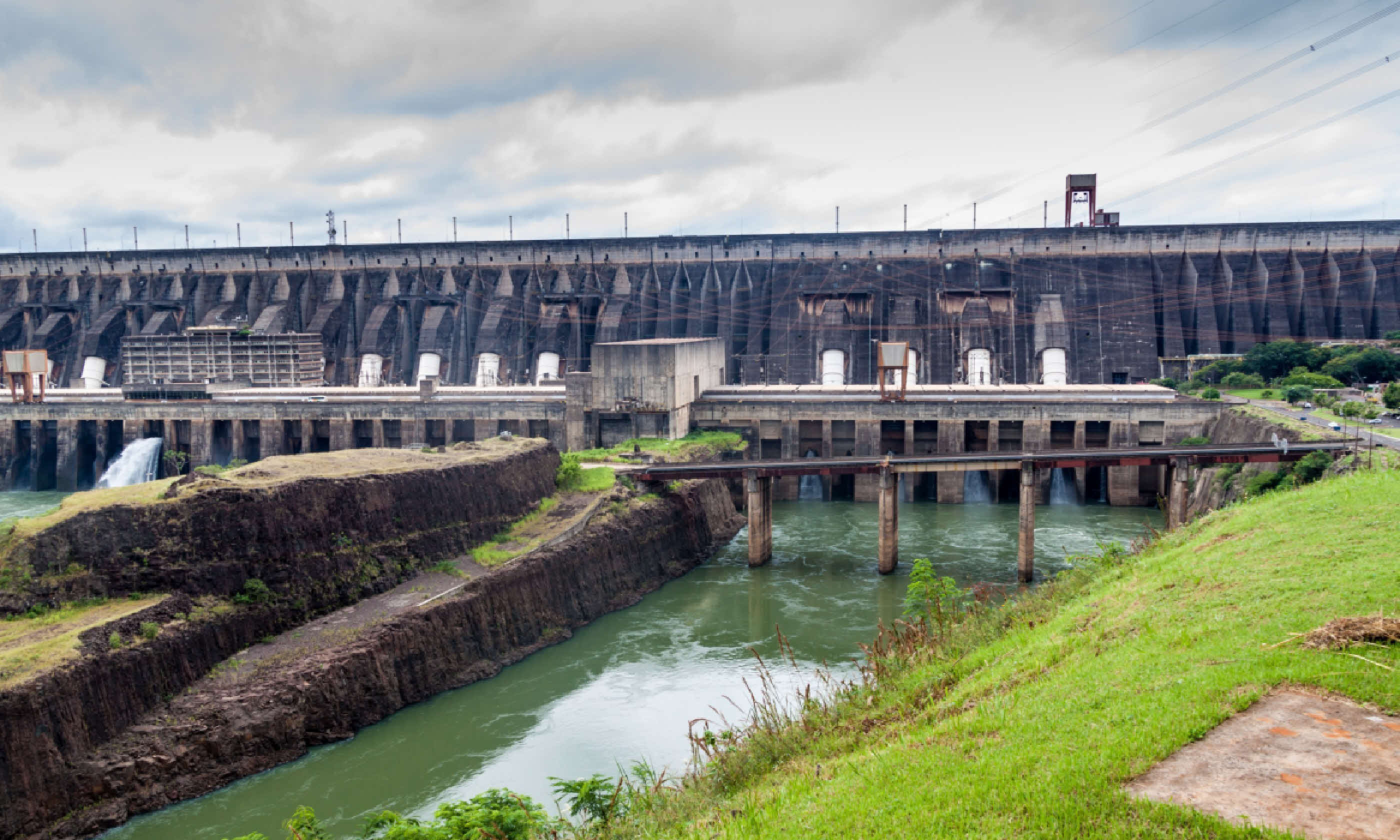 Itaipú Binacional Dam
Itaipú Binacional Dam
My idea to tour the Itaipú Binacional Dam on the Paraná, 20 minutes’ drive out of town, felt more promising. The joint Paraguayan/ Brazilian hydroelectricity project, the world’s second largest (after the Three Gorges Dam on the Yangtze), generates 90% of Paraguay’s and 20% of Brazil’s energy needs, according to a propaganda video shown at the smart ‘Tourist Complex’ that trumpets the achievement but avoids mention of homes submerged and people evicted.
Visits are free and include a bus ride over the colossal concrete dam with a stop at a viewing platform overlooking the gigantic sluice runs. Also ‘free’, courtesy of the dam(n) authorities, is entrance to the Tatí Yupí Nature Reserve, a Museum of Guaraní Culture and a zoo. Except that, despite my arriving within opening hours, the former two were closed.
“Everything is free, so they are free to shut when they feel like it,” explained a boredlooking woman on reception. The zoo, however, was open and ranks among the most miserable I have ever been to – pacing jaguars in too-small cages, moulting monkeys and broken-winged macaws. “Seen enough of Paraguay?” Rodrigo asked.
Crossing the bridge back to Brazil, I resolved to come back one day to do this country justice, to experience the authentic buzz of Asuncion, to see the jaguar and puma that inhabit the vast Chaco plains.
For the moment, however, it completed a hat trick of stamps in my passport and added one more flavour to savour, on a journey that had shown me natural splendours, ancient ruins, captivating wildlife and unqualified chaos. South America in a nutshell.
Make it happen...
The author travelled with
Journey Latin America. A tailormade itinerary includes flights, two nights’ B&B at the Belmond Hotels das Cataratas (Brazil), two nights’ full board at Yacutinga Lodge, three nights’ B&B at a four-star hotel in Puerto Iguazú (Argentina) and full day excursions to San Ignacio Miní and Paraguay.
British Airways flies from Heathrow to São Paolo and Buenos Aires. There are onward domestic flights to the (very close to one another) airports of Foz do Iguaçu (Brazil) and Puerto Iguazú (Argentina) with a variety of airlines including
TAM and
LAN.
Getting around
Taxis cross national borders without hindrance. There are regular buses to the falls from Puerto Iguazú and Foz do Iguaçu, and to Ciudad del Este. Transport to Yacutinga is included in the lodge price; car hire is advisable to explore further afield in Misiones province.
Accommodation
Belmond Hotel das Cataratas offers sublime comfort and views on the Brazilian side.
The only other hotel with a view of the falls (albeit from a greater distance) is the modern, four-star
Sheraton Iguazú in Argentina.
For cheaper options, stay in Puerto Iguazú town (more appealing than larger, sprawling Foz do Iguaçu). In the town centre,
Marcopolo Inn has B&B doubles. Stays at
Yacutinga Lodge include transport from Puerto Iguazú, full board and all jungle activities.
There is only budget accommodation in Ciudad de Este, of which the pick is
Hotel Mi Abuela.





